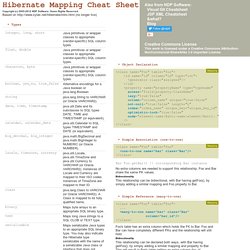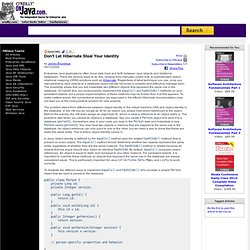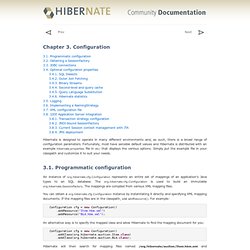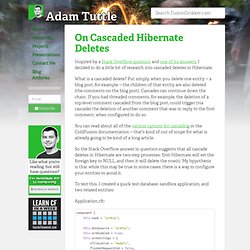

Hibernate Mapping Cheat Sheet. A many-to-many reference is basically a collection.

Class A holds a reference to a set of class B instances (as in the one-to-many case), but B might have multiple A's. Scenario We have two classes, Foo and Bar which are related to each other as follows: Set Foo.getBars() // of Bar instances<class name="Foo" table="foo"> ... <set role="bars" table="foo_bar"><key column="foo_id"/><many-to-many column="bar_id" class="Bar"/></set> </class> This time we cannot have an extra column on Bar as that would dictate that each Bar has only one Foo.
Bidirectionality This relationship can be declared both ways, with Bar having getFoos(), by suitable code changes to Bar and the following schema change: <class name="Bar" table="bar"> ... Now your Bars will know who their Foos are. No extra columns are generated for the bidirectionality. If you want independent collections of Foos on Bars and Bars on Foos (i.e. membership one way doesn't imply the other), you need to declare Bar's table to be bar_foo.
Don't Let Hibernate Steal Your Identity. By James Brundege 09/13/2006 Enterprise Java applications often move data back and forth between Java objects and relational databases.

There are several ways to do this, ranging from manually coded SQL to sophisticated object-relational mapping (ORM) solutions such as Hibernate. Regardless of what technique you use, once you start persisting Java objects to a database object identity becomes a complex and difficult-to-manage topic. The possibility arises that you will instantiate two different objects that represent the same row in the database. To handle this, you must properly implement the equals() and hashCode() methods on your persistent objects, but a proper implementation of these methods may be trickier than it at first appears.
The problem stems from differences between object identity in the virtual machine (VM) and object identity in the database. In Java, object identity is defined by the equals() method (and the related hashCode() method) that is present on every object. Mapping Java byte[] to MySQL binary(64) in Hibernate. Java - How to use UUID as primary key for Hibernate Entity. Optimistic Locking in Hibernate by default. Compound Primary Key video tutorial. Hibernate and JPA: An Introduction and Tutorial. Interested in training from the author of these tutorials?

See the upcoming Spring & Hibernate/JPA courses in Maryland, or contact hall@coreservlets.com for info on customized courses at your location. This tutorial was written by Matt Cherry and is derived from the world-renowned coreservlets.com Java EE training courses. It is intended as a fast introduction to Hibernate and JPA for people that are already familiar with Java programming. For learning basic Java, please see these tutorials. The Hibernate and JPA training course on which this tutorial is based is usually taught on-site at customer locations, but various Java EE training courses at public venues are periodically scheduled for people with too few developers for an onsite course.
If you find these free tutorials helpful, we would appreciate it if you would link to us. Source Code. Hibernate Tutorial. Welcome to YouTube! The location filter shows you popular videos from the selected country or region on lists like Most Viewed and in search results.To change your location filter, please use the links in the footer at the bottom of the page. Click "OK" to accept this setting, or click "Cancel" to set your location filter to "Worldwide". Java - Hibernate merge. [NOTE] Review. Java - Turning off hibernate logging console output. Chapter 3. Configuration. Hibernate's own connection pooling algorithm is, however, quite rudimentary.

It is intended to help you get started and is not intended for use in a production system, or even for performance testing. You should use a third party pool for best performance and stability. Just replace the hibernate.connection.pool_size property with connection pool specific settings. This will turn off Hibernate's internal pool. For example, you might like to use c3p0. [NOTE] Review. Hibernate Eclipse integration Example. In this tutorial you will see how to persist the java objects using the Hibernate Object/Relational Mapping (ORM) framework.

Hibernate automates ORM and considerably reduces the number of lines of code needed to persist the object in the database. This example demonstrates how to automatically generate code from the object/relational mapping file, thus saving the developers time. How to install Hibernate Tools in Eclipse. Hibernate Mapping Mystery « My Job Experiences. May 20, 2008 at 6:52 am | Posted in Hibernate | 10 Comments Hibernate is a framework that facilitate developers in order to get the maximum benefits of ORM (object/relational mapping is the automated (and transparent) persistence of objects in a Java application to the tables in a relational database, using metadata that describes the mapping between the objects and the database).

It eliminates the use of direct SQL queries by making application independent of database. Hibernate creates a layer between the application and database so that developers can take full advantage of object orientation with normalized database relations at the back end. Instead of going into the depth of hibernate, I would prefer to dive into the core concept of hibernate mapping between objects and relations; how objects oriented hierarchy can be mapped with relational database. Hibernate provides different types of mappings according to traditional relational databases. On Cascaded Hibernate Deletes. Inspired by a Stack Overflow question and one of its answers, I decided to do a little bit of research into cascaded deletes in Hibernate.

What is a cascaded delete? Put simply, when you delete one entity -- a blog post, for example -- the children of that entity are also deleted (the comments on the blog post). [NOTE] Preview. Course-Materials/pdf/hibernate. Hibernate - JBoss Community. Hibernate 3.0 Tutorial. What is Hibernate? What are JPA Annotations? Why do Hibernate Mapping -hbm- files suck? The Java Persistence API and Hibernate. From The Book On Hibernate.
JPA annotations greatly simplify persistence programming with Hibernate, but to understand why they're so great, it helps to understand what we needed to do before the introduction of annotations. Hibernate makes persisting the state of your Java objects incredibly simple.